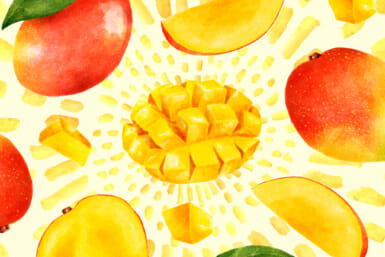The Taj Restaurant & Indian Food
I have traveled not quite the length but certainly the breadth of India, trying the foods om the curries in the south the tandoori in the north and vegetarian dishes everywhere.
I have gone from New Delhi south to Mysore and Calcutta west to Bombay, eating all along the way. So no one can accuse me of unfamiliarity with the cuisines of the subcontinent.
But some may wonder how a devout wine man can justify his taste for food whose spiciness is inimical to his favorite beverage. The answer is simple: He drinks beer. For a cold beer is not only an excellent accompaniment for a spicy dish but also an antidote for too-hot a curry.
It was in Sydney that I discovered the value of beer as a fire extinguisher. I had gone to a restaurant recommended by an Indian friend and, as I studied the menu, found that it had divided the curries into mild, medium and hot. Thinking that, out of respect for the bland Australian palate, the chef had lowered the thermal level of his dishes, I decided that a hot curry only could achieve the spiciness I like. It more than fulfilled my hope. The first forkful lit a raging fire on my tongue that took several quick swallows of beer to quench. Wine would never have been able to do it.
After trying Indian food not only all over India but all over the world, I have come to the conclusion that a city without at least one good Indian restaurant cannot consider itself in the gastronomic big leagues. The Taj restaurant in Akasaka-Mitsuke fulfills that in Tokyo.
As soon as I entered the Taj, I felt it would be good. For the decor was simple, and I have found that decor varies in inverse ratio with the food. Beware especially of those restaurants that try to establish an ersatz environment reminiscent of the home of their cuisine. At the Taj there is nothing identifably Indian, except for a picture or two that may represent Indian scenes. Its food was enough. There is no question as to its authenticity. What with eight chefs from Bombay and Delhi to see to it, the Taj provides as authentic an Indian cuisine as the ingredients here will allow.
I went there with my wife and a family friend. I like lo have at least one person with me when I check out a restaurant, as two opinions are better than one and a third will break a tie.
My wife and I decided to start out with panir pakoda, ¥700. It was slices of cheese dipped in a batter and deep-fried. They were very good and did the job of taking the edge off the appetite so that better judgement could be applied to the following dishes, which an empty stomach would not allow.
Our guest chose pant poori, ¥500, as a starter. Poori are small balls of dough deep-fried so they puff up. The pani is water with a mixture of cumin, coriander and chili flavors, with the cumin uppermost. It was an unusual and excellent appetizer.
Next came a mulligatawney soup, ¥500, for my wife and our guest. They agreed the spiciness was blended in such a way as to give enough spirit without overwhelming the tastebuds. But I don’t think it could have been as good as my rassam, a lentil-based tomato soup delicately flavored with chili. It was ¥600 and the ¥100 difference worth it.
For a main dish I chose my old favorite, tandoori chicken, described on the menu as tandoori murgh. I took a half-chicken, ¥1,800. Again, the touch of the master was obvious in its flavor, a master hand that knows too much from too little and how to make a happy blend of spices.
We had gone our separate ways in selecting the main dish. My wife took fish kofta curry, ¥1,400. which turned out to be minced fish shaped in balls, deep-fried and served in a spicy sauce. It was very good, and the two of them thought it was better than the chicken keema, ¥1,100, or chicken minced with green peas and mixed with spices, which our guest had ordered. I disagreed, I thought it was almost as good as my tandoori murgh.
Throughout we sipped delightedly on cool Lassi at ¥500 a glass. It was all that was needed for the delicately spiced food of the Taj.
As an afterthought, I asked for an order of sheek kabab, ¥1,600, to be shared among the three of us. It passed our taste test and, like everything we had eaten, could easily face up lo the most critical palate and come away with a hearty approval.
If one does not know what to order, the Taj offers several table-d’hote menus labeled in alphabetical order. A Course, for example, offers tandoori chicken, sheek kabab, naan, mutton curry, chicken curry, peas pillaw, kulfi (homemade ice cream), tea or coffee for ¥4,500 (pre-consumer tax price). There is even a cheaper course, the E Course for ¥2,600, which includes tandoori chicken, mutton curry, chicken keema, naan, rice and coffee.
The most expensive is the Special Course Dinner, including tandoori chicken, lamb chop, fish tikka, tandoori prawn, sherk kabab, noorani kabab (barbecued breast of chicken), mutton masala, peas pillaw, choice of sweets, tea or coffee. That one is ¥8,000.
There is even a vegetarian plate, begum thali, at ¥5.000. But it is not for the cholesterol-conscious, for an Indian vegetarian dish is cooked with enough ghee or clarified butter to stimulate the liver into even higher production levels of the scourge of the atherosclerotic.
The Taj is situated on the main street running from Akasaka-Mitsuke Crossing down to Toranomon Crossing right across from the Akasaka Tokyu Hotel. There are parking garages nearby. Telephone number is 585-0606/7. Its address is 3-2-7 Akasaka.








